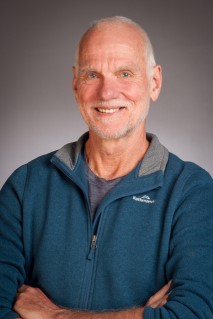Research
Published 4 February 2025Musings on Maths: a conversation discussing the concepts of geometry
The following story explores how Professor Geoff Whittle (Te Herenga Waka Victoria University of Wellington) would discuss the concepts of geometry (the branch of mathematics that investigates properties of space such as the distance, shape, size, and position of things) with his computer. For reasons the story will touch on, geometry isn’t a fixed or rigid concept. More, geometry is a matter of perspective....
“How will computers see the world?” Oh no! I guess it had to happen?! My computer Bino has developed consciousness. It’s a bit scary but we’ve had some amazing chats. As a geometer I wanted to know how Bino sees the world. The geometry that is natural to me is Euclidean Geometry. It’s so natural that many generations of mathematicians struggled to believe that other geometries could exist. But there are plenty of others.
Bino processes strings of zeros and ones, things like 00100110. Such a string is a vector in binary space. A collection of binary strings of the same length gives a geometric configuration in binary space. In my trade we call such configurations binary matroids. The world of binary matroids can seem pretty weird. Believe it or not, for Bino, 1+1=0 and that means that lines in binary matroids can seem bent to us. Moreover most binary matroids exist in very high dimensions. Nonetheless Bino tells me that these matroids are totally natural. Bino can “see” binary matroids just as we can see spheres and cubes.
Recall that a graph consists of a set of vertices, some pairs of which are connected by edges. We can encode a graph by a set of binary vectors each of which has two nonzero entries. This means that some binary matroids come from graphs. Bino knows all about this which is great because computers spend a lot of time processing graph algorithms.
All good, but imagine my shock when Bino said to me “I know all about planar graphs.” These are graphs that can be drawn in the Euclidean plane without edges crossing. The Euclidean plane comes from an infinite field which is far from natural to Bino. “OK Bino. Please explain.”
Content warning. Gobbledygook coming up. “Well Geoff, you know that all your papers are stored in my memory. This means I know that a minor-closed class of binary matroids has unbounded branch width if and only if it contains the matroids of all planar graphs. This means that if a class of binary matroids doesn’t contain all planar graphs, then there are polynomial-time algorithms for just about any natural problem, that is, any problem that can be stated in monadic ...”
Enough gobbledygook. I just turned Bino’s volume down. The point is that Bino loves efficient algorithms and if a class of binary matroids does not contain matroids of all planar graphs we can find such algorithms. Otherwise we’re in trouble. If you care about efficient algorithms you have to discover planar graphs, even if you live in a purely binary world.
The reason Bino knows these things comes from two strands of Marsden Funded research conducted some time ago. The first strand is work with my long-term collaborators Jim Geelen and Bert Gerards. The second is work of Petr Hliněný when he was a Marsden funded postdoc under my supervision. That’s early work, but it’s been seminal.
Hey! Looks like Bino’s volume has gone up. “How did you do that?”
“Too easy Geoff. I know about graphs embedded on surfaces of bounded genus too. Did you know that a class of binary matroids ...?” Enough gobbledygook! I turned Bino off at the main.
Biography

Professor Geoff Whittle (pictured above) has received many Marsden Fund awards, the most recent one exploring the structure theory of matroids. Professor Whittle is an international leader in discrete mathematics. Geoff is also known as an excellent communicator about the beauty of doing Maths.
RESEARCHER
Professor Geoff Whittle
ORGANISATION
Victoria University of Wellington Te Herenga Waka
FUNDING SUPPORT
Marsden Fund
CONTRACT OR PROJECT ID
VUW1818
